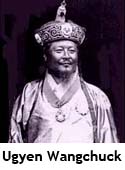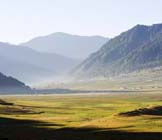Called Druk Yul (Land of the Thunder Dragon) by its people, the strikingly beautiful Kingdom of Bhutan lies in the eastern Himalayas, sandwiched between China andIndia.
In Bhutan's early years there wasn't a functional government, instead there were small monarchies ruled by a deb (king) scattered across the region. Tibetan-Mongol military forces overran the modest kingdoms by the 11th century, transforming the landscape into a single kingdom influenced by religion.
 Pre-modern Bhutan emerged in the 17th century with a theocratic government, founded by expatriate Drupka Monk, Ngawang Namgyal, who sought liberation from the oppressive Gelugpa subsect led by the Dalai Lama in Lhasa.
Pre-modern Bhutan emerged in the 17th century with a theocratic government, founded by expatriate Drupka Monk, Ngawang Namgyal, who sought liberation from the oppressive Gelugpa subsect led by the Dalai Lama in Lhasa. Under the guidance of Namgyal, Bhutan strengthened as a country, and successfully prevented invasions against Tibetan military forces throughout the 1600s.
Although invaders were kept at bay, civil unrest grew following the death of Namgyal - whose passing was kept a closely guarded secret for 54 years.
Bhutanese forces successfully invaded and occupied the kingdom of Cooch Behar in the 18th century, but were quickly ousted by the British East India Company in 1722. In addition to claiming the Cooch Behar territory, theBritish East India Company also invaded Bhutan in 1744.
Despite an attempt at a peace treaty between the two forces, small battles ultimately flared into the Duar War in 1864. Unfortunately, Bhutan lost against the British, and the Bengal Duars were ceded to the United Kingdom.
 Internal struggles persisted through the late 1800s, leading to the rise of Tongsa governor, Ugyen Wangchuck, who conquered his political enemies and united Bhutan.
Internal struggles persisted through the late 1800s, leading to the rise of Tongsa governor, Ugyen Wangchuck, who conquered his political enemies and united Bhutan. In 1907, Wangchuck was elected hereditary king of the country by an assembly of leading Buddhist monks, government officials, and heads of important families. Two years later, Bhutan signed the Treaty of Punakha grantingBritain control of the country's foreign affairs, and subsequently became an Indian princely state.
Long influenced by the cultures of the British government and India, Bhutan was granted independence from India in 1949. King Jigme Dorji Wangchuck instituted the new legislature, advocating a more democratic society, and in 1971 Bhutan joined the United Nations.
The transition from an absolute monarchy to a constitutional monarchy was made in 2008 and the first general elections were held.
Today Bhutan's major trading partner is India, however many of its people still live in poverty, with widespread illiteracy a major social problem.
Despite these shortcomings, based Bhutan is rated as one of the happiest countries in Asia.
 The small, landlocked country is completely bordered by mountains, making it difficult to navigate as there are few roads and no domestic (in-country)airlines or trains. Bhutan welcomes international travelers via (very pricey) Druk-Air, and the only ground entries into the country are through the towns of Phuntsholing and Samdrup Johghar.
The small, landlocked country is completely bordered by mountains, making it difficult to navigate as there are few roads and no domestic (in-country)airlines or trains. Bhutan welcomes international travelers via (very pricey) Druk-Air, and the only ground entries into the country are through the towns of Phuntsholing and Samdrup Johghar. The capital city of Thimphu sits at an altitude of 7,000 feet, on the banks of the Wong Chu river, and remains the site of royal government offices, and serves as a powerful magnet for adventure travelers from around the world.
No comments:
Post a Comment